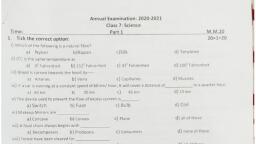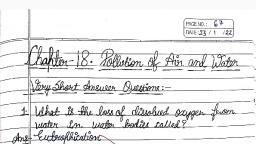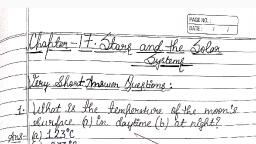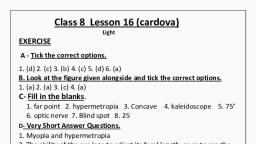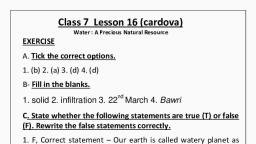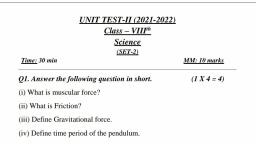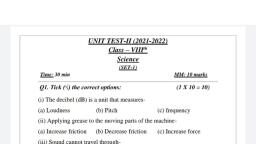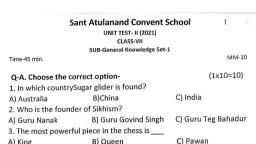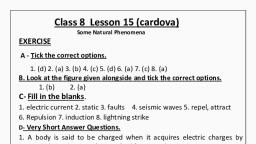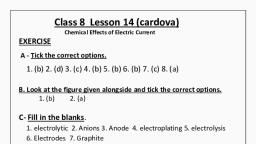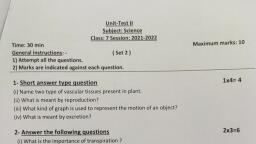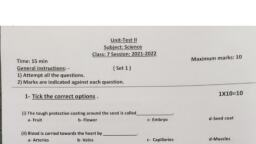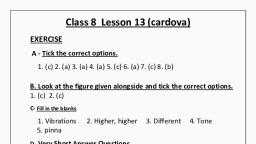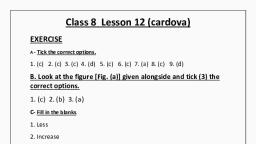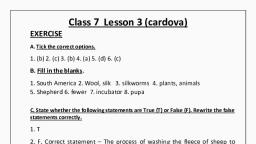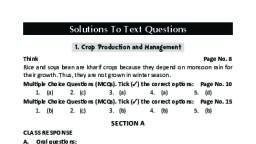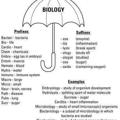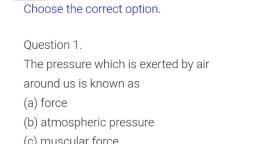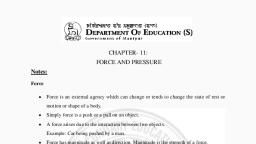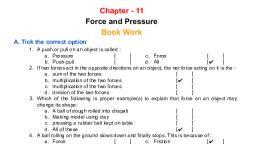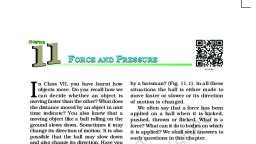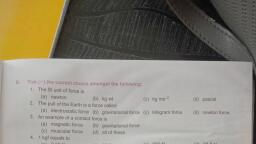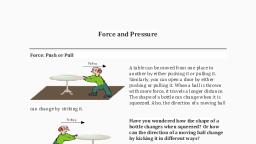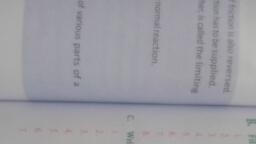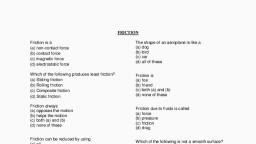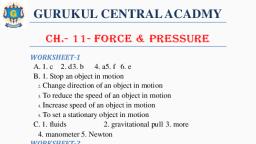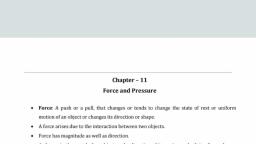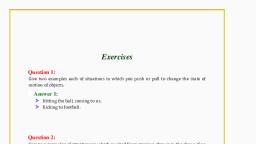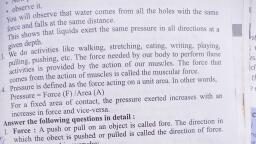Page 1 :
Class VIII, Chapter 11: Force and Pressure, Exercises, Answers to objective and subjective questions:A. Tick (√) the correct options., 1. (d), , 2.(a), , 3.(a), , 4.(c), , 5.(d), , B. Fill in the blanks., 1. Pressure, , 2. Equal, , 3. Pressure, , 4. Gravitational, , 5. Muscular, , 6. Force, , C.Very Short Answer Questions., 1. The resultant force will be the sum of both the forces., 2. N/m2 or Pascal., 3. The small bits of paper get attracted to the comb and stick to it because of electrostatic force., 4. The force required to lift a body of mass 1 kg vertically upwards is called one kilogram force., It is denoted by kgf., 5. The force acting along two surfaces in contact, which opposes the motion of one body over the, other, is called the force of friction or frictional force., 6. The Force acting on a unit area of an object is known as pressure., D.Short Answer Type-I Questions., 1. The five effects of force are:, (i) It can cause motion in a stationary body., (ii) It can stop a moving body., (iii) It can change the direction of motion of a moving body., (iv) It can change the speed of a moving body., (v) It can change the shape and size of a body., 2. The force resulting due to the action of muscles is known as muscular of force., For example, an elephant carries heavy load by the use of muscular force., 3. The force of attraction exerted by the earth on the objects due to which the objects fall, vertically downwards is called force of gravity., 4. To maintain the normal atmospheric pressure of their body, astronauts wear specially designed, spacesuits.
Page 2 :
5. The pressure is greater at 20 m below the surface of the sea because the pressure increases, with depth of a liquid or in the sea., 6. The pressure exerted by the air due to its own weight is known as Atmospheric pressure., 7. A wide steel belt is provided over the wheels of army tanks so as to reduce pressure on the, ground, otherwise the heavy wheels of tanks may sink in the ground., E.Short Answer Type-II Questions., 1. (a) The mountaineers suffer from nose bleeding at high altitudes because at high altitudes, the, atmospheric pressure is much lesser than our blood pressure. Due to this, some of the blood, capillaries burst and blood comes out through the nose of the mountaineers., (b) When we suck air at the upper end of the straw with our mouth, the pressure of the air inside, the straw is reduced. But the pressure acting on surface of the juice is equal to the atmospheric, pressure. So, the greater atmospheric pressure acting on the surface of the juice pushes the juice, up into the straw to our mouth., 2. (a) As the cutting edge is sharpened, the area of contact reduces which increases the pressure, over any object and hence, knife cuts objects easily., (b) To help our elders especially grandparents, 3. The two applications of atmospheric pressure from everyday life are:, (a) We are able to drink fruit juice with the help of a straw only due to the atmospheric pressure., (b) Rubber suction pad works due to the effect of atmospheric pressure., F. Long Answer Questions., 1. (a) A heavy truck is fitted with six to fourteen tyres because these tyres increase the area of, contact on which their weight acts and hence, reduce their pressure on the ground., (b) Skiers use long, flat skies to slide over snow because the area of contact is larger and, therefore lesser is the pressure on the snow, enabling the skier to slide over the snow without, sinking in the snow., (c) Foundations of high-rise buildings are kept wide, so that they exert less pressure on the, ground and do not sink in due to the extremely high pressure of the building., 2.(a) A school bag has wide straps made of thick cloth, so that the weight of the bag may fall, over large area of the shoulder of the child, producing less pressure on the shoulders and making, it more comfortable to carry the heavy school bag., (b) The walls of a dam are made thicker at the bottom because water pressure increases with, depth and a thicker wall can withstand a greater pressure exerted by the water at greater depth.
Page 3 :
3. (a) Types of contact forces:, (i) Frictional force: It is the force acting along the two surfaces in contact which opposes the, motion of one body over the other, e.g., a moving ball stops after some time due to frictional, force., (ii) Muscular force: It is the force resulting due to the action of muscles. Since our body is in, contact with the object, muscular force is a contact force, e.g., an elephant carries heavy load., (b) Types of non–contact forces:, (i) Magnetic force: If we bring a bar magnet near iron clips without touching each other, the, iron clips move from their original position towards the bar magnet under the influence of, magnetic force. So, magnetic force is a non-contact force., (ii) Electrostatic force: It is the force exerted by a charged body on another charged or, uncharged body, e.g., a charged comb attracts small pieces of paper., (iii) Gravitational force: Every object in this universe attracts every other object with a certain, force. This force with which two objects attract each other is called gravitational force., G. HOTS (Higher Order Thinking Skills) Questions., 1. Water comes out slowly from an upwards placed tap than from a similar tap downwards, because the liquid pressure increases with the depth. Thus, it flows faster in taps placed, downwards., 2. Some pulse grains got stuck into the polythene and did not fall because of the electrostatic, force developed between the two surfaces., H. Numerical., 1. Resultant force = (1000 + 1000) N = 2000 N, Reason: The resultant force (2000 N) is the sum of the two forces (1000 N each) acting upon the, object in same direction., 2. Force exerted by team A = (80 + 100 +120) N = 300 N, Force exerted by team B = (85 + 105 + 125) N = 315 N, Resultant force = Force exerted by team B – Force exerted by team A = (315 – 300) N = 15 N, So, Team B is the winner., 3. Area of contact = 10 m2, Force exerted by solid body on wooden plank = 250 N, Pressure = Force =, Area, , Force exerted by solid body on wooden plank, Area of contact, , = 250 N = 25 Pa, 10 m2
Page 4 :
4. Force exerted by the brick on the ground = 16 N, Area of brick = l×b = 32×10 = 320 cm2 = 0.032 m2 ( 1 m2 = 100 x 100 cm2), Pressure = Force =, Area, , Force exerted by the brick on the ground, Area of contact, , 5. Given,, Force = 120 N, Area, , = 3m2, , Pressure = Force, Area, , = 120 N = 40 Pa, 3 m2, , *********************, , =, , 16 N = 500 Pa, 0.032 m2

